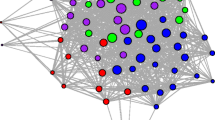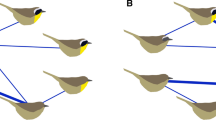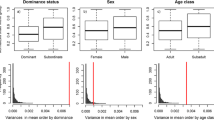Abstract
Groups of individuals frequently interact with each other, but typically analysis of such interactions is restricted to isolated dyads. Social network analysis (SNA) provides a method of analysing polyadic interactions and is used to analyse interactions between individuals. We use a population of 12 groups (ca. 250 animals) of wild meerkats (Suricata suricatta) to test whether SNA can also be used to describe and elucidate patterns of inter-group interactions. Using data collected over 24 months, we constructed two sets of networks, based on direct encounters between groups and instances of roving males visiting other groups. We analysed replicated networks of each type of interaction to investigate similarities between networks of different social interactions as well as testing their stability over time. The two network types were similar to each other when derived from long-term data, but showed significant differences in structure over shorter timescales where they varied according to seasonal and ecological conditions. Networks for both types of inter-group interaction constructed from data collected over 3 months reliably described long-term (12- and 24-month) patterns of interactions between groups, indicating a stable social structure despite variation in group sizes and sex ratios over time. The centrality of each meerkat group in roving interactions networks was unaffected by the sex ratio of its members, indicating that male meerkats preferentially visit geographically close groups rather than those containing most females. Indeed, the strongest predictors of network structure were spatial factors, suggesting that, in contrast to analyses of intra-group interactions, analyses of inter-group interactions using SNA must take spatial factors into account.





Similar content being viewed by others
References
Adams ES, Mesterton-Gibbons M (2003) Lanchester’s attrition models and fights among social animals. Behav Ecol 14:719–723
Barnard JA (2000) Costs and benefits of group foraging in cooperatively breeding meerkats. Ph.D. thesis, University of Cambridge
Borgatti SP, Everett MG, Freeman LC (2002) Ucinet for windows: software for social network analysis. Analytic Technologies, Harvard, MA
Christley RM, Pinchbeck GL, Bowers RG, Clancy D, French NP, Bennett R, Turner J (2005) Infection in social networks: using network analysis to identify high-risk individuals. Am J Epidemiol 162:1024–1031
Clayton WD, Harman KT, Williamson H (2006) GrassBase—the Online World Grass Flora. http://www.kew.org/data/grasses-db.html.
Clutton-Brock TH, Gaynor D, Kansky R, MacColl ADC, McIlrath G, Chadwick P, Brotherton PNM, O’Riain JM, Manser M, Skinner JD (1998) Costs of cooperative behaviour in suricates, Suricata suricatta. Proc R Soc Lond B 265:185–190
Clutton-Brock TH, Maccoll A, Chadwick P, Gaynor D, Kansky R, Skinner JD (1999) Reproduction and survival of suricates (Suricata suricatta) in the southern Kalahari. Afr J Ecol 37:69–80
Corner LAL, Pfeiffer DU, Morris RS (2003) Social-network analysis of Mycobacterium bovis transmission among captive brushtail possums (Trichosurus vulpecula). Prev Vet Med 59:147–167
Croft DP, Krause J, James R (2004) Social networks in the guppy (Poecilia reticulata). Proc R Soc Lond B 271:S516–S519
Cross PC, Lloyd-Smith JO, Bowers JA, Hay CT, Hofmeyr M, Getz WM (2004) Integrating association data and disease dynamics in a social ungulate: bovine tuberculosis in African buffalo in the Kruger National Park. Ann Zool Fenn 41:879–892
Doolan SP, Macdonald DW (1996) Dispersal and extra-territorial prospecting by slender-tailed meerkats (Suricata suricatta) in the south-western Kalahari. J Zool 240:59–73
Flack JC, Girvan M, de Waal FBM, Krakauer DC (2006) Policing stabilizes construction of social niches in primates. Nature 439:426–429
Hanneman RA, Riddle M (2005) Introduction to social network methods. Published in digital form at: http://www.faculty.ucr.edu/~hanneman/nettext/, University of California, Riverside.
Jordan NR, Cherry MI, Manser M (2007) Latrine distribution and patterns of use by wild meerkats: implications for territory and mate defence. Anim Behav 73:613–622
Krause J, Croft D, James R (2007) Social network theory in the behavioural sciences: potential applications. Behav Ecol Sociobiol 62:15–27
Lusseau D, Newman MEJ (2004) Identifying the role that animals play in their social networks. Proc R Soc Lond B 271:S477–S481
Lusseau D, Wilson BEN, Hammond PS, Grellier K, Durban JW, Parsons KM, Barton TR, Thompson PM (2006) Quantifying the influence of sociality on population structure in bottlenose dolphins. J Anim Ecol 75:14–24
McComb K, Packer C, Pusey A (1994) Roaring and numerical assessment in contests between groups of female lions, Panthera leo. Anim Behav 47:379–387
McDonald DB (2007) Predicting fate from early connectivity in a social network. Proc Natl Acad Sci U S A 104:10910–10914
Radford AN, du Plessis MA (2004) Territorial vocal rallying in the green woodhoopoe: factors affecting contest length and outcome. Anim Behav 68:803–810
Ross-Gillespie A, Griffin AS (2007) Meerkats. Curr Biol 17:R442–R443
Ryder TB, McDonald DB, Blake JG, Parker PG, Loiselle BA (2008) Social networks in the lek-mating wire-tailed manakin (Pipra filicauda). Proc R Soc Lond B 275:1367–1374
Thomas POR, Croft DP, Morrell LJ, Davis A, Faria JJ, Dyer JRG, Piyapong C, Ramnarine I, Ruxton GD, Krause J (2008) Does defection during predator inspection affect social structure in wild shoals of guppies. Anim Behav 75:43–53
Wasserman S, Faust K (1994) Social network analysis: methods and applications. Cambridge University Press, Cambridge. doi:1994
Wey T, Blumstein DT, Shen W, Jordán F (2008) Social network analysis of animal behaviour: a promising tool for the study of sociality. Anim Behav 75:333–344
Whitehead H (1997) Analysing animal social structure. Anim Behav 53:1053–1067
Whitehead H, Dufault S (1999) Techniques for analyzing vertebrate social structure using identified individuals: review and recommendations. Adv Study Behav 28:33–74
Wilson ML, Britton NF, Franks NR (2002) Chimpanzees and the mathematics of battle. Proc R Soc Lond B 269:1107–1112
Wolf JBW, Mawdsley D, Trillmich F, James R (2007) Social structure in a colonial mammal: unravelling hidden structural layers and their foundations by network analysis. Anim Behav 74:1293–1302
Young AJ, Carlson AA, Clutton-Brock T (2005) Trade-offs between extraterritorial prospecting and helping in a cooperative mammal. Anim Behav 70:829–837
Young AJ, Spong G, Clutton-Brock T (2007) Subordinate male meerkats prospect for extra-group paternity: alternative reproductive tactics in a cooperative mammal. Proc R Soc Lond B 274:1603–1609
Acknowledgements
Tim Clutton-Brock provided scientific advice, allowed us to work on the meerkat population of the Kalahari Meerkat Project and provided access to the long-term data from the project. We thank the owners of farms surrounding the Reserve for permission to study meerkats on their land and Northern Cape Conservation for allowing us to work in the Kalahari. Tom Flower, Rob Sutcliffe and Dave Bell managed the Meerkat Project with aplomb. We are greatly indebted to all the volunteers who assisted with data collection in the field. Martin Haupt of the University of Pretoria supplied invaluable logistical support. This manuscript was greatly improved by comments from two anonymous referees. JAD was funded by the Department for Environment, Food and Rural Affairs and the Higher Education Funding Council for England through the Cambridge Infectious Diseases Consortium. JRM was funded by a BBSRC grant to Tim Clutton-Brock.
Author information
Authors and Affiliations
Corresponding author
Additional information
Communicated by J. Setchell
Rights and permissions
About this article
Cite this article
Drewe, J.A., Madden, J.R. & Pearce, G.P. The social network structure of a wild meerkat population: 1. Inter-group interactions. Behav Ecol Sociobiol 63, 1295–1306 (2009). https://doi.org/10.1007/s00265-009-0782-x
Received:
Revised:
Accepted:
Published:
Issue Date:
DOI: https://doi.org/10.1007/s00265-009-0782-x




